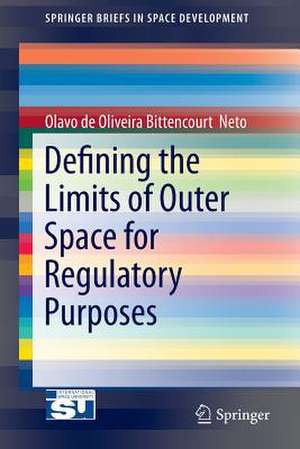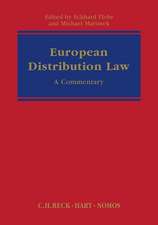Defining the Limits of Outer Space for Regulatory Purposes: SpringerBriefs in Space Development
Autor Olavo de Oliviera Bittencourt Netoen Limba Engleză Paperback – iun 2015
Din seria SpringerBriefs in Space Development
-
 Preț: 262.68 lei
Preț: 262.68 lei -
 Preț: 379.09 lei
Preț: 379.09 lei -
 Preț: 378.12 lei
Preț: 378.12 lei -
 Preț: 379.09 lei
Preț: 379.09 lei -
 Preț: 380.07 lei
Preț: 380.07 lei -
 Preț: 477.72 lei
Preț: 477.72 lei -
 Preț: 474.84 lei
Preț: 474.84 lei - 15%
 Preț: 463.35 lei
Preț: 463.35 lei -
 Preț: 376.96 lei
Preț: 376.96 lei -
 Preț: 410.77 lei
Preț: 410.77 lei - 15%
 Preț: 463.35 lei
Preț: 463.35 lei -
 Preț: 410.39 lei
Preț: 410.39 lei - 15%
 Preț: 461.87 lei
Preț: 461.87 lei -
 Preț: 380.45 lei
Preț: 380.45 lei -
 Preț: 378.34 lei
Preț: 378.34 lei -
 Preț: 377.35 lei
Preț: 377.35 lei - 5%
 Preț: 358.48 lei
Preț: 358.48 lei -
 Preț: 443.58 lei
Preț: 443.58 lei -
 Preț: 378.12 lei
Preț: 378.12 lei -
 Preț: 425.27 lei
Preț: 425.27 lei -
 Preț: 317.73 lei
Preț: 317.73 lei -
 Preț: 444.74 lei
Preț: 444.74 lei -
 Preț: 477.17 lei
Preț: 477.17 lei -
 Preț: 344.53 lei
Preț: 344.53 lei -
 Preț: 378.12 lei
Preț: 378.12 lei
Preț: 378.34 lei
Nou
Puncte Express: 568
Preț estimativ în valută:
72.40€ • 78.62$ • 60.82£
72.40€ • 78.62$ • 60.82£
Carte tipărită la comandă
Livrare economică 22 aprilie-06 mai
Preluare comenzi: 021 569.72.76
Specificații
ISBN-13: 9783319166841
ISBN-10: 3319166840
Pagini: 136
Ilustrații: XI, 110 p. 76 illus., 60 illus. in color.
Dimensiuni: 155 x 235 x 10 mm
Greutate: 0.19 kg
Ediția:2015
Editura: Springer International Publishing
Colecția Springer
Seria SpringerBriefs in Space Development
Locul publicării:Cham, Switzerland
ISBN-10: 3319166840
Pagini: 136
Ilustrații: XI, 110 p. 76 illus., 60 illus. in color.
Dimensiuni: 155 x 235 x 10 mm
Greutate: 0.19 kg
Ediția:2015
Editura: Springer International Publishing
Colecția Springer
Seria SpringerBriefs in Space Development
Locul publicării:Cham, Switzerland
Public țintă
ResearchCuprins
Introduction.- Air Space and Outer Space.- The Delimitation in Discussion.- Proposals.- The "Protozone"/"Mesospace" Situation.- National Legislation and Comparative Law.- Towards a Compromise.- Final Remarks.- Bibliography.
Notă biografică
Olavo de O. Bittencourt Neto is Professor Doctor at the Catholic University of Santos, Brazil and Post Doctoral Researcher at the University of Sao Paulo, Brazil. He is a member of the Board of Directors of the International Institute of Space Law. He has been part of Brazilian Delegations before the United Nations Committee on Peaceful Uses of Outer Space (UNCOPUOS) since 2009, providing legal assistance to the diplomatic staff on Space Law and International Law. In 2012, Olavo received the IISL Diederiks-Verschoor Award for his paper “The Elusive Frontier: Revisiting the Delimitation of Outer Space”.
Textul de pe ultima copertă
With different countries ascribing to different theories of air space and outer space law, Dr. Bittencourt Neto proposes in this Brief a reassessment of the international law related to the extension of state territories vertically. Taking into consideration the vast number of proposals offered by scholars and diplomatic delegations on this subject matter, as well as the principles of comparative law, a compromise to allow for peaceful development is the only way forward. The author argues for setting the delimitation of the frontier between air space and outer space at 100 km above mean sea level through an international treaty. This would also regulate passage rights for space objects during launchings and reentries, as long as those space activities are peaceful, conducted in accordance with international Law and respecting the sovereign interests of the territorial State. Continuing expansion of the commercial space industry and conflicting national laws require a stable and fair legal framework best adjudicated by the United Nations, instead of allowing a patchwork system to persist. The proper framework for developing such regulation is carefully discussed from all angles with a practical recommendation for policy-makers in the field.
Caracteristici
Based on a Diederiks-Verschoor Award-winning paper presented at the International Institute of Space Law in 2012 Outlines past attempts and proposals for regulating the delimitation of outer space for the purposes of satellite deployment and other uses of space Argues the importance of reaching a multilateral solution to avoid international conflicts of jurisdiction















